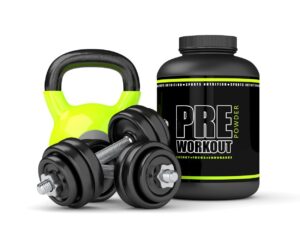
Investigating the advantages of strength training is a key factor in understanding how this kind of physical exercise can promote total well-being and health. The physiology suggested regular resistance training as an effective way to improve body composition, muscle strength, and even mental well-being.
This post will delve into resistance training and its numerous physical benefits, such as power training that protects bone health and boosts energy levels. Beyond the physical advantages, we’ll also show how regular strength training exercises can enhance your cognitive function.
We’ll guide you on starting your journey with resistance training in accordance with guidelines from trusted organizations like the Canadian Fitness Education organization CanFitPro. Lastly, we’ll highlight common mistakes to avoid during your exercise routine to ensure you reap all these benefits of resistance training without setbacks or injuries.
Table of Contents:
- What is Resistance Training?
- Physical Benefits of Resistance Training
- Mental Benefits of Resistance Training
- How to Get Started with Resistance Training
- Frequently Asked Questions About Getting Started With Resistance Training:
- 5 Common Mistakes to Avoid When Doing Resistance Training
- Frequently Asked Questions on the Benefits of resistance training
- FAQs in Relation to the Benefits of Resistance Training
- Conclusion
1. What is Resistance Training?
Resistance training, also known as strength or weight training, involves challenging your muscles with force, such as dumbbells, resistance bands, or even your body weight. It’s like giving your muscles a tough love workout.
Resistance training offers numerous benefits that can positively impact overall health and well-being. Whether you aim to enhance your physical appearance, lift your spirits, or become stronger for everyday activities – resistance training has something for everyone. It’s like a one-stop shop for fitness.
A Brief Overview
In essence, when you do resistance training exercises consistently over time, the stress causes microscopic damage to the muscle fibers. This kind of exercise induces damage to the muscle fibers, prompting the body’s repair system, leading to bigger and more powerful muscles – a phenomenon often known as hypertrophy. It’s like giving your muscles a makeover.
This form of exercise isn’t just about bulking up, though; it has wide-ranging benefits beyond aesthetics. From enhancing bone density and joint flexibility to promoting fat loss and reducing the risk of injury – these are all impressive outcomes of incorporating regular resistance workouts into one’s routine. It’s like a superhero workout for your body.
Different Types Of Resistance Training
- Isometric Resistance: Involves contracting your muscles against a non-moving object, like pushing against a wall. It’s like trying to move a mountain.
- Elastic Resistance: Utilizes elastic equipment like rubber tubing or stretchy bands. It’s like a workout with a bungee cord.
- Free Weights: Uses barbells and dumbbells where gravity provides the force against which you work out. It’s like lifting heavy stuff to get strong.
- Machines: These use pulleys & levers that provide variable amounts of weights for lifting during workout sessions. It’s like having a personal trainer in machine form.
No matter what type suits you best: whether using free weights at a home gym setup or machines at commercial gyms – each method offers unique advantages that can help achieve specific fitness goals effectively while keeping things interesting. It’s like having a buffet of workout options.
Physical Benefits of Resistance Training

Increase Muscle Mass and Strength
Resistance training makes you stronger than a superhero and gives you muscles that could rival the Hulk.
Better Body Composition
With resistance training, you can say goodbye to flab and hello to a toned and sexy physique.
Improved Bone Health
Resistance training not only makes you look good, but strength training protects bone health, as well. It also keeps you sturdy like a fortress.
Promotes Better Balance and Coordination
Resistance training can help you stay steady and sure-footed, so you can show off your moves without stumbling over your laces.
To sum it up, Resistance training is the secret sauce to becoming a muscle-bound, bone-strengthening, coordination-mastering machine. So grab those weights and get ready to flex.
Mental Benefits of Resistance Training

If you thought resistance training only benefits your physique, think again. The mental health perks are equally impressive. Let’s delve into how this form of exercise helps boost not just your biceps but also your brainpower.
Mood Enhancement and Energy Boost
The Canadian Fitness Education Organization CanFitPro notes that strength training exercises can significantly improve mood and energy. When doing resistance training, the body secretes endorphins – hormones that give a feeling of contentment. These natural mood lifters help combat stress, anxiety, and even depression.
Better Focus and Concentration
A study suggested regular resistance training could enhance cognitive function. By improving blood flow to the brain during workouts, exercisers can experience improved focus and concentration.
Improved Sleep Quality
Another often overlooked benefit is better sleep quality. Regular physical activity like strength training has been shown to aid in falling asleep faster, sleeping deeper, and waking up less frequently throughout the night.
Chronic Conditions Management
HHS Physical Activity Guidelines note that strength training plays a significant role in managing chronic conditions. It aids in controlling symptoms related to various chronic conditions, such as arthritis or back pain, by strengthening muscles around affected joints, reducing discomfort.
Fighting Cognitive Decline
Last but not least: warding off cognitive decline. Research shows that aerobic activity and strength training protects against this loss more effectively than aerobic exercise alone.
Remember, folks: while it’s important to keep moving for cardiovascular health, don’t forget about those weights either – they’re crucial for maintaining both physical and mental fitness.
How to Get Started with Resistance Training
If you’re inexperienced with fitness, resistance training may seem daunting. But fear not. Here’s some advice to get you started like an expert.
Create a Plan
Before you hit the weights, make a plan. Set goals, decide on workout frequency, and choose exercises. Need help? Check out beginner-friendly routines online.
Start Slowly
Don’t rush into it. Begin with lighter weights and gradually increase as you get stronger. Rome wasn’t built in a day, after all.
Prioritize Proper Form
Form is everything. Maintain proper form to target the right muscles and avoid injury. Consider working with a trainer for guidance.
Incorporate Rest Days
Rest is crucial. Give your muscles time to recover and grow. Embrace those rest days like a boss.
Frequently Asked Questions About Getting Started With Resistance Training:
- How often should I do resistance training?
- Aim for 2-3 sessions a week to get the most benefit. You got this.
- I’m worried about getting injured – what precautions should I take?
- Warm up, cool down, and prioritize form. Seek counsel from an expert if uncertain. Safety first.
- I’m not seeing results – what am I doing wrong?
- If you’re not seeing progress, consult a health and wellness expert. They’ll help you troubleshoot like a champ.
Remember: The journey to better health and fitness is a marathon, not a sprint. Enjoy the process and celebrate those small victories along the way.
5 Common Mistakes to Avoid When Doing Resistance Training
Avoid ruining your resistance training routine by steering clear of these common errors. Here are some mistakes to avoid:
Mistake 1: Not Warming Up Properly
Warm up those muscles, or you’ll be saying “ouch.”
Mistake 2: Lifting Too Heavy, Too Soon
Slow and steady wins the race, not a trip to the ER.
Mistake 3: Neglecting Form Over Weight
Don’t sacrifice form for gains unless you’re into injuries.
Mistake 4: Skipping Recovery Time
Rest days are like chocolate cake for your muscles. Yum.
Mistake 5: Ignoring Nutrition
Feed your muscles the good stuff, or they’ll be hangry.
By avoiding these mistakes, you’ll be flexing and feeling fabulous in no time.
Frequently Asked Questions on the Benefits of resistance training
Got questions about resistance training? We’ve got answers.
1. Is Resistance Training Good for Weight Loss?
Oh yeah. Resistance training burns calories during your workout and keeps burning them even after you’re done. It’s like a calorie-burning party that lasts all day. Plus, having more muscle means you’ll be torching calories even when you’re chilling on the couch.
2. Can I Do Resistance Training Every Day?
Well, it depends. Give those muscles a breather. Most experts recommend a 48-hour break between workouts targeting the same muscle group. Your muscles require time to recuperate and develop, as you need an opportunity to gorge and watch your #1 program.
3. Does Resistance Training Improve Bone Health?
Absolutely. Pumping iron isn’t just for show. Studies demonstrate that engaging in strength training can result in sturdier bones than ever. Say goodbye to fragile bones and hello to a sturdy skeleton.
4. What Equipment Do I Need for Resistance Training?
You don’t need fancy equipment to get started. Bodyweight exercises like push-ups and squats are a great way to challenge those muscles. For those looking to maximize their gains, dumbbells and kettlebells are the perfect way to push your workout further. Time to get swole.
Note:
FAQs in Relation to the Benefits of Resistance Training
What are the 5 benefits of resistance training?
Resistance training can increase muscle strength, improve bone density, boost energy levels, aid in weight management, and enhance mental well-being.
What are the 4 specific benefits of resistance training?
The four key benefits include enhancing muscle mass, protecting bone health, increasing metabolism rate for better calorie burn-off, and improving physical performance.
Why is resistance training so important to our daily lives?
HHS Physical Activity Guidelines note that regular strength training helps maintain functional ability and prevent chronic mobility problems.
What are the ACSM benefits of resistance training?
The American College of Sports Medicine suggests regular resistance exercise improves cardiovascular health, enhances overall body composition, and reduces risk for injury and disease conditions like osteoporosis.
Wrapping Up- The Benefits of Resistance Training
Resistance training: the secret to a stronger body and mind!
Physiology suggests regular strength training exercises can protect bone health and boost energy levels.
According to the Canadian fitness education organization canfitpro, incorporating strength training into your fitness routine can prevent chronic mobility problems and enhance muscle strength.
While aerobic workouts are great, they aren’t the only game in town for building muscle and staying fit.
The HHS physical activity guidelines note that strength training is as important as aerobic activity for overall health.
So, don’t forget to grab those free weights and get your muscles pumping!
Remember, strength training is not just for bodybuilders but anyone looking to improve their physical and mental well-being.
So, why wait? Start your strength training journey today and reap the benefits!
And remember, always consult with a healthcare professional before starting any new exercise routine.
Stay strong, stay fit!



